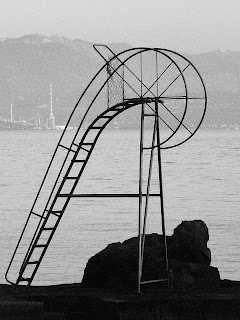 |
| The huddle, Rijeka Children's Parade |
Rijeka, our town, takes Carnivale VERY seriously. In fact, Rijeka claims to have the third largest Carnival celebration in the world -- behind Rio and Venice (where we'll be next week). While we've seen bits of it here and there, the streamers lining the entire pedestrian area, the little wooden huts selling northwestern Croatian goodies, and the ubiquitous advertisements, today we really saw Carnivale.
We went downtown at 1:00PM for the official children's parade and didn't see the last entry until 4:15PM. I've seen my share of parades, working for a Congressman and forcing stickers on everyone under ten years of age on the parade route, and I've taken my own kids to practically every parade within a 30 mile radius of East Lansing, including the Gizzardfest parade in Potterville MI. But this was unlike any parade I've ever seen before, and this was just the kids' part!

Behind the the "carnivale master" were four people dressed as Rijeka's town mascot, called a "morcic" (with Croatian accents marks over each of the c's, I don't know how this is pronounced, but if you say something like "mor-chick" downtown, you'll surely be directed to the nearest tourist souvenir stand). It's a black face and a white turban, and it symbolizes victory over the Turks in the 16th century. To our eyes, it looks like an incredibly racist image, there's no way around it. This is the "it" souvenir one is supposed to take home from Rijeka, but I'm embarrassed when I walk by a display of them in the shop windows.
After the morcic, there were a couple of baton twirling troupes, then the kids, kids, and more kids. Almost 80 schools were represented from Rijeka and the neighboring towns (even a few from Slovenia), each with a full-blown costume of some motif (in no particular order... fruit, elves, wizards, sheep, Native Americans, Middle Eastern shieks and shiekesses, butterflies, bees, Africans, scarecrows, gnomes, candy, cacti, colored pencils, happy faces, suns, musical instruments, etc. etc. etc.). Each of the 80 or so entries had between 30 to 60 kids and several adults, all costumed to the hilt. It was freezing if the sun wasn't shining right on you, so after seeing 40 or so entries we ducked into a coffee shop near the parade route and got pastries, hot chocolate, and coffee.
When we left the cafe, we were astounded that the parade still wasn't over, so we walked back to the parade route and serendipitously caught the highlight of the parade (serendipitously because we thought the rest of the parade would be school groups). What we actually saw was a UNESCO "intangible cultural heritage" phenomena -- village bell-ringers. Or rather, we got to see the village youth rehearsing this event and learning how to be grown up bell ringers. It's hard to explain, so here's a video in English about the bell-ringers if you've got the time (
http://www.unesco.org/culture/ich/index.php?RL=00243).
Basically, depending on the village from which they originate, the bell ringers wear bells around their middles and HUGE head regalia in the shape of scary animals and sheep. They ring the bells by bumping into each other, and periodically, they huddle into a group (facing outward, though) and bang their bells until they get wine (or maybe kool aid for the kids) and can rest their heads from the weight of these massive costumes, then they keep going. There is the occasional nasty bear who causes mischief until he's put back in line. You can't help but think that Maurice Sendak saw one of these processions before writing "Where the Wild Things Are". It's really an amazing sight, and these were just kids!
 |
| A bell ringer in training, Rijeka Children's Parade |
 |
| Cactus costumes, Rijeka Children's Parade |
 |
| Shiek costumes, Rijeka Children's Parade |
 |
| Georgie |
 |
| Morcics, Rijeka Children's Parade |
 |
| Lucy |
 |
| Jonah |
Sadly, there was a lot of confetti thrown out, but no candy. Which was probably all for the best, because nothing gets me competitive like candy at a parade (a personality deficiency stemming from a youth without candy in the house).















































